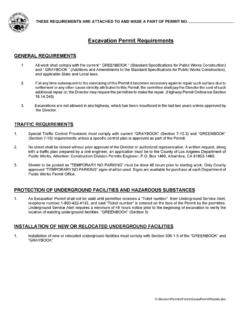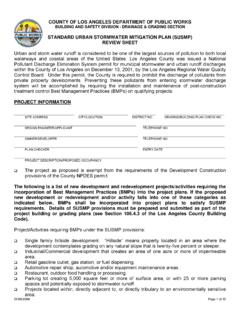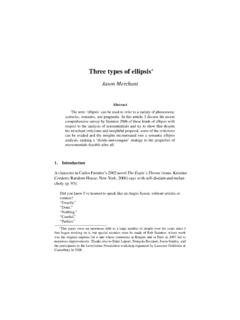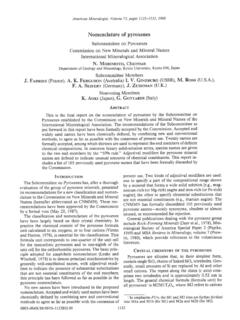Transcription of Peter J. Pitchess Honor Rancho - ladpw.org
1 SOURCES OF WATERAn assessment of the drinking water sources for PPHR was completed in August 2002. The assessment evaluates the vulnerability of water sources to contamination and helps determine whether more protective measures are needed. The active well sources are considered most vulnerable to the activities listed below.* Well 10: Transportation Corridors- freeways/ state highways* Wells 15 & 17: Chemical/ Petroleum pipelines* Well 18R: Chemical/ Petroleum pipelines, farm chemical distribution/application service, pesticide/petroleum/fertilizer storage and transfer area. Wells- agricultural/irrigation, oil, gas, and geothermal copy of the complete assessment is available at the California Department of Public Health Los Angeles Office, 500 North Central Avenue, Suite 500, Glendale CA 91203.
2 You may request a summary of the assessment by contacting Mr. Dmitry Ginzburg at (818) OUR CUSTOMERSEach year, Peter J. Pitchess Honor Rancho (PPHR) provides this report to inform you, our customers, about the quality of the water you drink. We are pleased to report that during the 2013 calendar year, your water met or surpassed all health-based drinking water order to ensure that tap water is safe to drink, the Environmental Protection Agency (USEPA) and the California Department of Public Health (CDPH) prescribe regulations that limit the amount of certain contaminants in water provided by public water regulations also establish limits for contaminants in bottled water that provide the same protection for public health. To meet these regulations, PPHR contracts with the Los Angeles County Waterworks Districts to oversee water quality monitoring and you for taking the time to read our Annual Water Quality Report.
3 We look forward to another year of providing you with safe, reliable informe contiene informacion muy importante sobre su agua potable. Traduzcalo o hable con alguien que lo entienda PARTICIPATIONAND CONTACT INFORMATIONFor questions or comments regarding water quality, please contact Mr. Bill Bennett at (661) 295-8025. To view this report on the internet, please visit the Los Angeles County Waterworks District website at AnnuAlWAter QuAlity report Water testing performed in 2013 Peter J. PitchessHonor RanchoDRINKING WATER & YOUR HEALTHD rinking water, including bottled water, may reasonably be expected to contain at least small amounts of some contaminants. The presence of contaminants does not necessarily indicate that water poses a health risk.
4 More information about contaminants and potential health effects can be obtained by calling the Environmental Protection Agency s (USEPA) Safe Drinking Water Hotline (1-800-426-4791).The sources of drinking water (both tap water and bottled water) include rivers, lakes, streams, ponds, reservoirs, springs, and wells. As water travels over the surface of the land or through the ground, it dissolves naturally-occurring minerals and, in some cases, radioactive material, and can pick up substances resulting from the presence of animals or from human that may be present in source water include:* Microbial contaminants, such as viruses and bacteria, that may come from sewage treatment plants, septic systems, agricultural livestock operations, and wildlife.* Inorganic contaminants, such as salts and metals, that can be naturally-occurring or result from urban stormwater runoff, industrial or domestic wastewater discharges, oil and gas production, mining, or farming.
5 * Pesticides and herbicides, that may come from a variety of sources such as agriculture, urban stormwater runoff, and residential uses.* Organic chemical contaminants, including synthetic and volatile organic chemicals, that are by-products of industrial processes and petroleum production, and can also come from gas stations, urban stormwater runoff, agricultural application, and septic systems.* Radioactive contaminants, that can be naturally-occurring or be the result of oil and gas production and mining people may be more vulnerable to contaminants in drinking water than the general population. Immuno-compromised persons such as persons with cancer undergoing chemotherapy, persons who have undergone organ transplants, people with HIV/AIDS or other immune system disorders, some elderly, and infants can be particularly at risk from infections.
6 These people should seek advice about drinking water from their health care providers. USEPA/Centers for Disease Control (CDC) guidelines on appropriate means to lessen the risk of infection by Cryptosporidium and other microbial contaminants are available from the Safe Drinking Water Hotline (1-800-426-4791).WATER CONSERVATION TIPSIn addition to protecting the quality of water delivered to you, we also promote and implement water conservation programs for the Districts customers. For tips on how to conserve water and to learn more about the programs we offer, visit or contact Rea Gonzalez at (626) 300-3338. We can all take these simple steps to conserve water:Indoor* Fix indoor faucet and toilet leaks. Just a drip can waste more than 10,000 gallons per month. * Turn off the water while you brush your teeth or shave.
7 * Take shorter showers and install a water efficient showerhead.* Wash only full loads in the dishwasher and washing * Water according to current weather and season.* Adjust your sprinkler heads so they water the yard, not the sidewalk or street. * Landscape your yard and garden with California native and drought-tolerant plants. These plants are accustomed to local weather and soil conditions and thrive with little summer watering. Using them not only saves water, but also saves maintenance time and produces a habitat for native birds, beneficial insects and wildlife. The best time to plant native plants is between October and May each & COPPERIf present, elevated levels of lead can cause serious health problems, especially for pregnant women and young children. Lead in drinking water is primarily from materials and components associated with service lines and home plumbing.
8 The District is responsible for providing high quality drinking water, but cannot control the variety of materials used in plumbing components. When your water has been sitting for several hours, you can minimize the potential for lead exposure by flushing your tap for 30 seconds to 2 minutes before using water for drinking or cooking. If you are concerned about lead in your water, you may wish to have your water tested. Information on lead in drinking water, testing methods, and steps you can take to minimize exposure is available from the Safe Drinking Water Hotline or PRIMARY DRINKING WATER STANDARDS SUBSTANCE (UNIT OF MEASURE) YEAR MCL [MRDL] PHG [MCLG] RANGE AVERAGE TYPICAL SOURCE SAMPLED LOW-HIGH LEVEL (2013)Chlorine** (ppm) 2013 [ ] as CI2 MRDLG = 4 - Drinking water disinfectant added for treatment as CI2 Combined Radium (pCi/L) 2008 - 13 5 0 0 - Erosion of natural depositsFluoride (ppm) 2011 - 13 1 - Erosion of natural deposits; water additive that promotes strong teeth.
9 Discharge from fertilizer and aluminum factoriesGross Alpha Particle Activity (pCi/L) 2008 - 13 15 [0] - Erosion of natural depositsGross Beta Particle Activity (pCi/L) 2010 50 [0] Decay of natural and man-made depositsHaloacetic Acids [HAA5]** (ppb) 2013 60 N/A 0 - Byproduct of drinking water disinfectionNitrate as NO3 (ppm) 2013 45 45 - Runoff and leaching from fertilizer use; leaching from septic tanks and sewage; erosion of natural depositsUranium (pCi/L) 2008 - 13 20 - Erosion of natural deposits Total Trihalomethanes [TTHMs]** (ppb) 2013 80 N/A - Byproduct of drinking water disinfectionTable Definitions90th Percentile: Out of every 10 homes sampled, 9 were at or below this Level (AL): The concentration of a contaminant which, if exceeded, triggers treatment or other requirements that a water system must Contaminant Level (MCL): The highest level of a contaminant that is allowed in drinking water.
10 Primary MCLs are set as close to the PHGs (or MCLGs) as is economically and technologically feasible. Secondary MCLs are set to protect the odor, taste, and appearance of drinking Contaminant Level Goal (MCLG): The level of a contaminant in drinking water below which there is no known or expected risk to health. MCLGs are set by the Environmental Protection Residual Disinfectant Level (MRDL): The highest level of a disinfectant allowed in drinking water. There is convincing evidence that addition of a disinfectant is necessary for control of microbial Residual Disinfectant Level Goal (MRDLG): The level of a drinking water disinfectant below which there is no known or expected risk to health. MRDLGs do not reflect the benefits of the use of disinfectants to control microbial Drinking Water Standard (PDWS): MCLs and MRDLs for contaminants that affect health along with their monitoring and reporting requirements, and water treatment Health Goal (PHG): The level of a contaminant in drinking water below which there is no known or expected risk to health.








